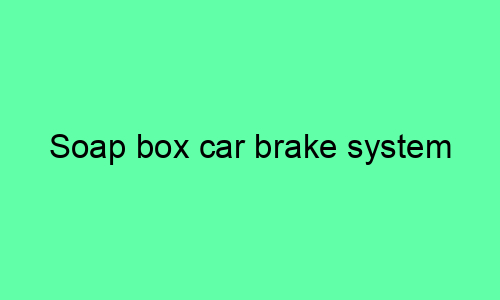Soap Box Car Brake Systems
Introduction
A brake system is an essential component of any soap box car, as it allows the driver to control the speed and direction of the car. There are a variety of different brake systems that can be used on soap box cars, each with its own advantages and disadvantages. The most common type of brake system is the mechanical brake, which uses a system of levers and cables to apply force to the wheels. Other types of brake systems include hydraulic brakes, which use fluid to transmit force to the wheels; and pneumatic brakes, which use air to transmit force to the wheels.
Types of Brake Systems
Mechanical Brakes
Mechanical brakes are the most common type of brake system used on soap box cars. They are simple to design and build, and they are relatively inexpensive. Mechanical brakes work by using a system of levers and cables to apply force to the wheels. When the driver presses on the brake pedal, the levers and cables pull on the brake shoes, which press against the wheels and slow the car down.
Hydraulic Brakes
Hydraulic brakes are more powerful than mechanical brakes, and they are more resistant to wear and tear. Hydraulic brakes work by using fluid to transmit force to the wheels. When the driver presses on the brake pedal, the fluid pressure increases, which forces the brake pads against the wheels and slows the car down.
Pneumatic Brakes
Pneumatic brakes are the most powerful type of brake system, and they are the most resistant to wear and tear. Pneumatic brakes work by using air to transmit force to the wheels. When the driver presses on the brake pedal, the air pressure increases, which forces the brake pads against the wheels and slows the car down.
Choosing a Brake System
The type of brake system that is best for a particular soap box car will depend on a variety of factors, including the weight of the car, the speed of the car, and the terrain that the car will be used on. For light soap box cars that will be used on flat terrain, mechanical brakes may be sufficient. For heavier soap box cars or cars that will be used on hilly terrain, hydraulic or pneumatic brakes may be necessary.
Designing a Brake System
When designing a brake system for a soap box car, there are a few key factors to keep in mind. First, the brake system must be strong enough to stop the car safely. Second, the brake system must be easy to use. Third, the brake system must be durable enough to withstand the rigors of soap box car racing.
Installing a Brake System
Once the brake system has been designed, it can be installed on the soap box car. The installation process will vary depending on the type of brake system that is being used. However, there are some general steps that can be followed for all brake system installations.
- Mount the brake components on the soap box car.
- Connect the brake lines.
- Bleed the brake system.
- Test the brake system.
Maintaining a Brake System
Once the brake system has been installed, it is important to maintain the system regularly. This will help to ensure that the brake system is always in good working order. Some of the maintenance tasks that should be performed on a regular basis include:
- Checking the brake fluid level.
- Inspecting the brake pads for wear.
- Bleeding the brake system.
- Testing the brake system.
Troubleshooting Brake Problems
If the brake system is not working properly, there are a few things that can be checked. First, check the brake fluid level. If the brake fluid level is low, add more brake fluid. Next, inspect the brake pads for wear. If the brake pads are worn, replace them. Finally, bleed the brake system. If the brake system is still not working properly, there may be a more serious problem. In this case, it is best to take the soap box car to a mechanic for diagnosis and repair.
Conclusion
A brake system is an essential component of any soap box car. By following the steps outlined in this article, you can design, install, and maintain a brake system that will help to keep your soap box car safe and under control.






